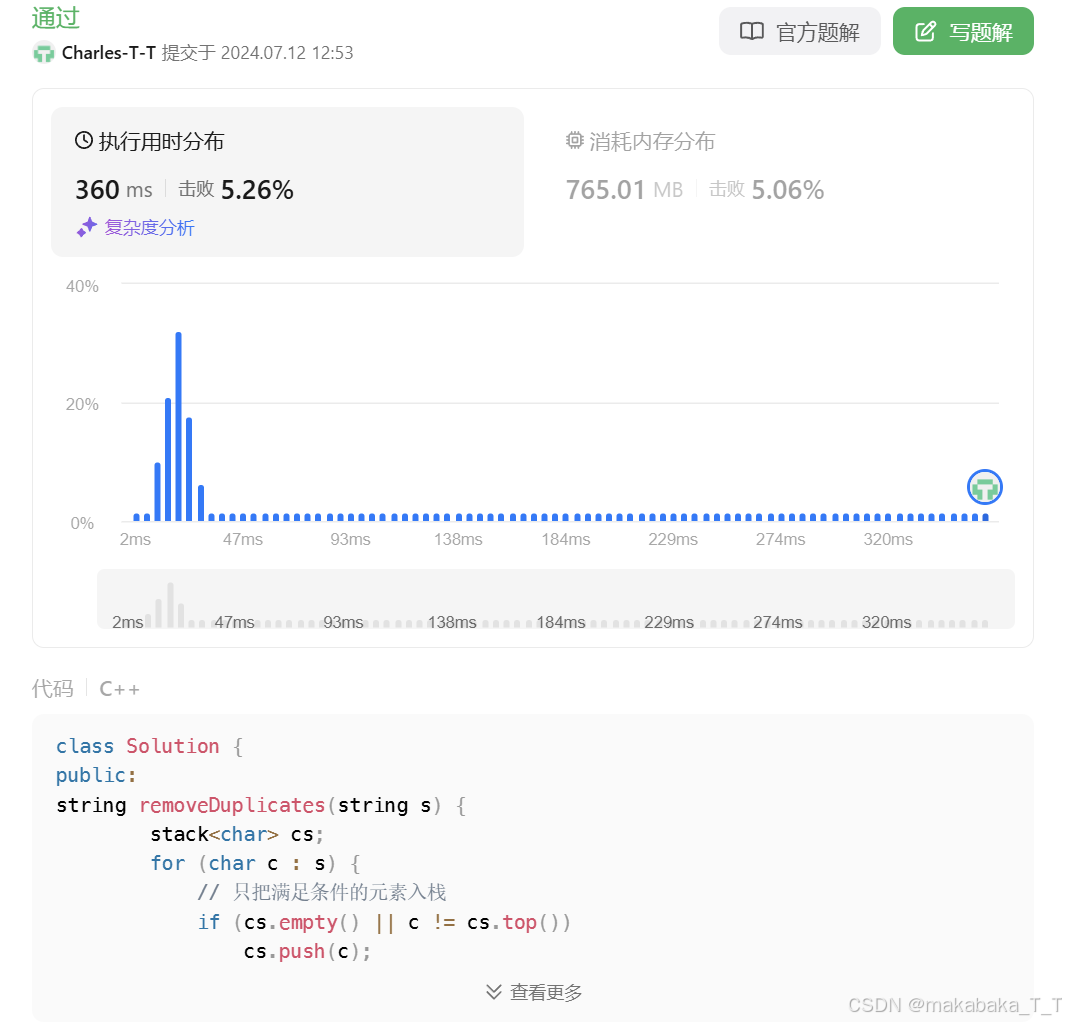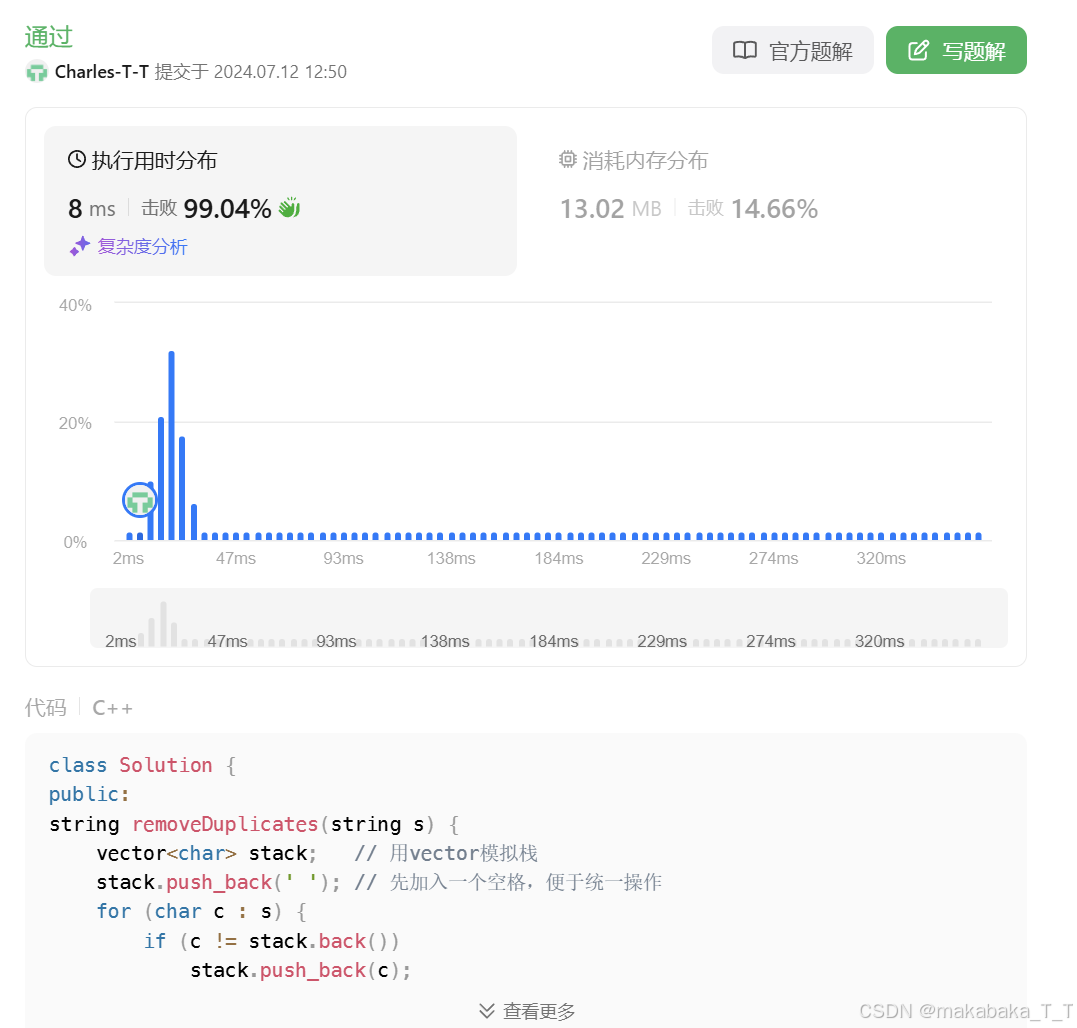232. 用栈实现队列
题目描述
请你仅使用两个栈实现先入先出队列。队列应当支持一般队列支持的所有操作(push、pop、peek、empty):
实现 MyQueue 类:
void push(int x)将元素 x 推到队列的末尾int pop()从队列的开头移除并返回元素int peek()返回队列开头的元素boolean empty()如果队列为空,返回true;否则,返回false
说明:
- 你 只能 使用标准的栈操作 —— 也就是只有
push to top,peek/pop from top,size, 和is empty操作是合法的。 - 你所使用的语言也许不支持栈。你可以使用 list 或者 deque(双端队列)来模拟一个栈,只要是标准的栈操作即可。
示例 1:
输入:
["MyQueue", "push", "push", "peek", "pop", "empty"]
[[], [1], [2], [], [], []]
输出:
[null, null, null, 1, 1, false]
解释:
MyQueue myQueue = new MyQueue();
myQueue.push(1); // queue is: [1]
myQueue.push(2); // queue is: [1, 2] (leftmost is front of the queue)
myQueue.peek(); // return 1
myQueue.pop(); // return 1, queue is [2]
myQueue.empty(); // return false
提示:
1 <= x <= 9- 最多调用
100次push、pop、peek和empty - 假设所有操作都是有效的 (例如,一个空的队列不会调用
pop或者peek操作)
进阶:
- 你能否实现每个操作均摊时间复杂度为
O(1)的队列?换句话说,执行n个操作的总时间复杂度为O(n),即使其中一个操作可能花费较长时间。
题解
思路很简单:用两个栈来回 “倒” ,像两杯水来回倒那样,就可以模拟队列。
比如用栈 s1 作为实际存储结构,另一个栈 s2 作为辅助结构,要获得“队头”,即 s1 的栈底元素,可以将 s1 中元素依次出栈、入栈 s2 ,这样最后在 s2 栈顶的就是原来 s1 的栈底,即队头元素。
代码(C++)
class MyQueue
{
private:
stack<int> s1; // 本体
stack<int> s2;
public:
MyQueue(){}
void push(int x)
{
s1.push(x);
}
int pop()
{
// s1倒进s2
while (!s1.empty()) {
s2.push(s1.top());
s1.pop();
}
// 出队列
int top = s2.top();
s2.pop();
// s2倒回s1
while (!s2.empty()) {
s1.push(s2.top());
s2.pop();
}
return top;
}
int peek()
{
// s1倒进s2
while (!s1.empty()) {
s2.push(s1.top());
s1.pop();
}
// 记录队头元素
int top = s2.top();
// s2倒回s1
while (!s2.empty()) {
s1.push(s2.top());
s2.pop();
}
// 返回队头元素
return top;
}
bool empty()
{
return s1.empty();
}
};
不过上面这种实现方式在涉及栈顶元素的操作时,总是需要倒两遍( s1 ➡️ s2 ➡️ s1 ),哪怕连续 peek 也是每次如此,比较麻烦。
我们还可以进一步优化,以达到题目的进阶要求:每个操作均摊时间复杂度为 O ( 1 ) O(1) O(1) 。方法是让两个栈分别负责“入队列”和“出队列”,分开维护:
class MyQueue
{
private:
stack<int> stIn;
stack<int> stOut;
public:
MyQueue() {}
void push(int x)
{
stIn.push(x);
}
int pop()
{
// 如果stOut为空,需要先倒入此时的stIn
if (stOut.empty()) {
while (!stIn.empty()) {
stOut.push(stIn.top());
stIn.pop();
}
}
// 出队列(stOut出栈)并返回队头(stOut栈顶)
int top = stOut.top();
stOut.pop();
return top;
}
int peek()
{
int top = this->pop(); // 直接复用pop()
stOut.push(top); // 记得要加回去
return top;
}
bool empty()
{
return stIn.empty() && stOut.empty();
}
};
Golang中没有现成的栈和队列,所以这里用go也写一下:
这里就直接实现队列了,先实现栈、再用它来实现队列的思路同上。
type MyQueue struct {
s []int
}
func Constructor() MyQueue {
return MyQueue{}
}
func (queue *MyQueue) Push(x int) {
queue.s = append(queue.s, x)
}
func (queue *MyQueue) Pop() int {
top := queue.s[0]
queue.s = queue.s[1:]
return top
}
func (queue *MyQueue) Peek() int {
return queue.s[0]
}
func (queue *MyQueue) Empty() bool {
return len(queue.s) == 0
}
225. 用队列实现栈
题目描述
请你仅使用两个队列实现一个后入先出(LIFO)的栈,并支持普通栈的全部四种操作(push、top、pop 和 empty)。
实现 MyStack 类:
void push(int x)将元素 x 压入栈顶。int pop()移除并返回栈顶元素。int top()返回栈顶元素。boolean empty()如果栈是空的,返回true;否则,返回false。
注意:
- 你只能使用队列的标准操作 —— 也就是
push to back、peek/pop from front、size和is empty这些操作。 - 你所使用的语言也许不支持队列。 你可以使用 list (列表)或者 deque(双端队列)来模拟一个队列 , 只要是标准的队列操作即可。
示例:
输入:
["MyStack", "push", "push", "top", "pop", "empty"]
[[], [1], [2], [], [], []]
输出:
[null, null, null, 2, 2, false]
解释:
MyStack myStack = new MyStack();
myStack.push(1);
myStack.push(2);
myStack.top(); // 返回 2
myStack.pop(); // 返回 2
myStack.empty(); // 返回 False
提示:
1 <= x <= 9- 最多调用
100次push、pop、top和empty - 每次调用
pop和top都保证栈不为空
进阶: 你能否仅用一个队列来实现栈。
题解
思路很简单,用两个队列, q1 作为实际存储结构, q2 作为辅助数据结构,涉及栈顶的操作则将 q1 “倒入” q2 并注意留下最后一个元素(即 q1 队尾元素)作为栈顶元素即可。
代码(C++)
class MyStack
{
private:
queue<int> q1; // q1是本体
queue<int> q2;
public:
MyStack() {}
void push(int x)
{
q1.push(x);
}
int pop()
{
// q1倒进q2,留意最后一个值
int size = q1.size();
for (int i = 0; i < size - 1; i++) {
q2.push(q1.front());
q1.pop();
}
int top = q1.front();
q1.pop();
// q2倒回q1
while (!q2.empty())
{
q1.push(q2.front());
q2.pop();
}
// 返回栈顶
return top;
}
int top()
{
int top;
// q1倒进q2,留意最后一个值
while (1)
{
top = q1.front();
q2.push(top);
q1.pop();
if (q1.empty())
break;
}
// q2倒回q1
while (!q2.empty())
{
q1.push(q2.front());
q2.pop();
}
// 返回栈顶
return top;
}
bool empty()
{
return q1.empty();
}
};
这样思路应该是最简单的,但是实现也比较繁琐,因为需要经常在两个队列之间倒腾元素。我们可以优化一下,达到题目进阶要求中的只用一个队列实现:
由于队列是“先进先出”的数据结构,上面用两个队列的地方其实完全可以仅用一个队列实现:根据情况将其队头元素插到队尾即可
class MyStack
{
private:
queue<int> q;
public:
MyStack() {}
void push(int x)
{
q.push(x);
}
int pop()
{
int size = q.size();
for (int i = 0; i < size - 1; i++) {
q.push(q.front());
q.pop();
}
int top = q.front();
q.pop();
return top;
}
int top()
{
int top = this->pop();
q.push(top);
return top;
}
bool empty()
{
return q.empty();
}
};
Golang中没有现成的栈和队列,所以这里用go也写一下:
这里就直接实现栈了,先实现队列、再用它来实现栈的思路同上。
type MyStack struct {
slice []int
}
func Constructor() MyStack {
return MyStack{}
}
func (st *MyStack) Push(x int) {
st.slice = append(st.slice, x)
}
func (st *MyStack) Pop() int {
top := st.slice[len(st.slice) - 1]
st.slice = st.slice[0 : len(st.slice) - 1]
return top
}
func (st *MyStack) Top() int {
top := st.Pop()
st.slice = append(st.slice, top)
return top
}
func (st *MyStack) Empty() bool {
return len(st.slice) == 0
}
20. 有效的括号
题目描述
给定一个只包括 '(',')','{','}','[',']' 的字符串 s ,判断字符串是否有效。
有效字符串需满足:
- 左括号必须用相同类型的右括号闭合。
- 左括号必须以正确的顺序闭合。
- 每个右括号都有一个对应的相同类型的左括号。
示例 1:
输入:s = "()"
输出:true
示例 2:
输入:s = "()[]{}"
输出:true
示例 3:
输入:s = "(]"
输出:false
提示:
1 <= s.length <= 104s仅由括号'()[]{}'组成
题解
一道用于理解“栈”的很好题目。思路有点像求逆波兰表达式(应该说这题是逆波兰表达式的基础):
-
左括号无脑入栈
-
遇到右括号,检查当前栈顶是否为相应的左括号(这就检查了右括号是否顺序闭合),是就弹出左括号,否则返回false
这里还要注意:先检查栈是否为空
-
其他字符不入栈
-
最后,如果栈为空,说明所有括号都配对正确,返回true;否则,返回false
代码(C++)
bool isValid(string s)
{
stack<char> st;
for (const char &c : s){
switch (c)
{
case '(':
case '[':
case '{':
st.push(c);
break;
case ')':
if (st.empty() || st.top() != '(')
return false;
else
st.pop();
break;
case ']':
if (st.empty() || st.top() != '[')
return false;
else
st.pop();
break;
case '}':
if (st.empty() || st.top() != '{')
return false;
else
st.pop();
break;
default:
break;
}
}
return st.empty();
}
这个代码直观但是有点长,浅改一下:
bool isValid(string s)
{
stack<char> st;
unordered_map<char, char> cMap = {
{')', '('},
{']', '['},
{'}', '{'}
};
for (char c : s)
{
if (cMap.find(c) != cMap.end()) {
if (st.empty() || st.top() != cMap[c])
return false;
st.pop();
} else if (c == '(' || c == '[' || c == '{')
st.push(c);
}
return st.empty();
}
1047. 删除字符串中的所有相邻元素
题目描述
给出由小写字母组成的字符串 S,重复项删除操作会选择两个相邻且相同的字母,并删除它们。
在 S 上反复执行重复项删除操作,直到无法继续删除。
在完成所有重复项删除操作后返回最终的字符串。答案保证唯一。
示例:
输入:"abbaca"
输出:"ca"
解释:
例如,在 "abbaca" 中,我们可以删除 "bb" 由于两字母相邻且相同,这是此时唯一可以执行删除操作的重复项。之后我们得到字符串 "aaca",其中又只有 "aa" 可以执行重复项删除操作,所以最后的字符串为 "ca"。
提示:
1 <= S.length <= 20000S仅由小写英文字母组成。
题解
这题一看就和 LeetCode 20. 有效的括号 很像,可以采用类似的思路,即将字符逐个入栈,期间检查:若当前字符与栈顶字符相同,就将栈顶字符弹出。最后,将栈中字符重新连成字符串即可。
好像消消乐 👀
代码(C++)
string removeDuplicates(string s)
{
stack<char> cs;
for (char c : s) {
if (!cs.empty()) {
if (c == cs.top())
cs.pop();
else
cs.push(c);
} else
cs.push(c);
}
string res = "";
while (!cs.empty()) {
res = cs.top() + res; // 栈顶元素加入字符串头部
cs.pop();
}
return res;
}
但进一步思考可以发现,其实没必要这样“先加入,再检查,不符合条件就出栈”,而可以“先检查,确定能加再加入”:
string removeDuplicates(string s) {
stack<char> cs;
for (char c : s) {
// 只把满足条件的元素入栈
if (cs.empty() || c != cs.top())
cs.push(c);
else
cs.pop();
}
string res = "";
while (!cs.empty())
{
res = cs.top() + res; // 栈顶元素加入字符串头部
cs.pop();
}
return res;
}
不过这两种方法受栈操作的较低效率限制,速度较慢:
我们可以用 vector 模拟栈,进一步优化实际运行速度:
string removeDuplicates(string s) {
vector<char> stack; // 用vector模拟栈
stack.push_back(' '); // 先加入一个空格,便于统一操作
for (char c : s) {
if (c != stack.back())
stack.push_back(c);
else
stack.pop_back();
}
return string(stack.begin() + 1, stack.end());
}
这种写法的时空开销都小不少,LeetCode上看到运行速度明显提升:

